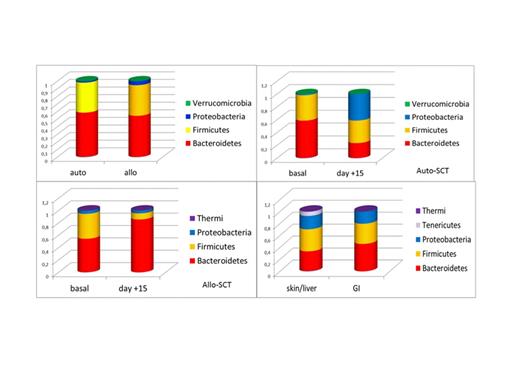Abstract
Introduction:
Disruption of the intestinal barrier after stem cell transplantation (SCT), as a consequence the conditioning regimen, may significantly affect the gastrointestinal (GI) microbiome and thus the immune response of gut associated lymphoid tissue. Indeed, dysbiosis of the microbioma has been reported to trigger a variety of human diseases, such as inflammatory bowel disorders and acute infections. In the SCT setting, a correlation has been identified between changes in the microbioma and post-SCT events, such as as graft versus host disease (GvHD), infections and transplant related mortality (TRM).
Patients:
The aim of our study was to analyze the human gut microbiome composition before and after transplantation and to assess a relationship, if any, between microbiome imbalance and post-transplant outcome. For this purpose, we prospectively studied 11 patient (pts), 8 undergoing an allogeneic (matched sibling, n=7, unrelated n=1) and 3 an autologous SCT. The diagnosis was AML (n=8) or multiple myeloma (n=3); the age ranged between 30 and 60 (median 48). The allogeneic SCT patients were prepared with a myeloablative regimen (n=5) or a reduced intensity regimen (n=3); the myeloma patients received Melphalan 200 mg/m^2. Antibiotic prophylaxis was given to the allogeneic SCT recipient. Stool samples were collected at baseline before starting SCT conditioning in both groups and on day +15. Among the allo-SCT patients, another sample was provided at the time of GvHD onset. Samples were stored at -80°C until they were processed. . DNA was isolated with QIAamp DNA Stool Mini kit. The hypervariable V1-V3 region of the 16s RNA gene was amplified by PCR and sequenced on 454 GS Junior Titanium. Taxonomic composition was defined according to Greengenes database. IBM SPSS Statistics 22 was used for statistical analysis.
Results:
The baseline microbiome composition in auto-SCT and allo-SCT patients was comparable. In the auto-SCT, day +15 samples showed a reduction of Bacteroidetes and an increase of Proteobacteria (p=0.0071) compared with baseline. In the allo-SCT setting, at day +15 we identified an increase of Bacteroidetes and a reduction of Firmicutes (p=0.0023). At the time of GvHD onset, patients showed a reduction of Bacteroidetes. with an increase of Firmicutes and Proteobacteria (t-test, p=0.0020). Surprisingly, Bacteroidetes were more represented in patients with GvHD-GI involvement than in the others (t-test, p=0.0001). Figure 1.
Discussion and conclusion:
We identified that, starting from the same baseline microbioma composition, the conditioning regimen promoteschanges in the microbiome, which are different between auto- and allo-SCT. After auto-SCT we documented an increase of Proteobacteria (Klebsiella, Proteus, Acinetobacter, Haemophilus, Pseudomonas, Enterobacteriaceae) and a reduction of Bacteroidetes (Bacteroides, Saprospirae, Prevotella). After allo-SCT, instead, there was an increase of Bacteroidetes and a reduction of Firmicutes (Bacilli, Lactobacilli, Clostridium, Enterococci, Streptococci). Moreover, patients who developed GvHD harboured more Firmicutes and Proteobacteria and less Bacteroidetes than pts without this complication. In patients with gut GvHD, Proteobacteria were more represented than in pts with liver or skin involvement.
No relevant conflicts of interest to declare.
Author notes
Asterisk with author names denotes non-ASH members.


This feature is available to Subscribers Only
Sign In or Create an Account Close Modal